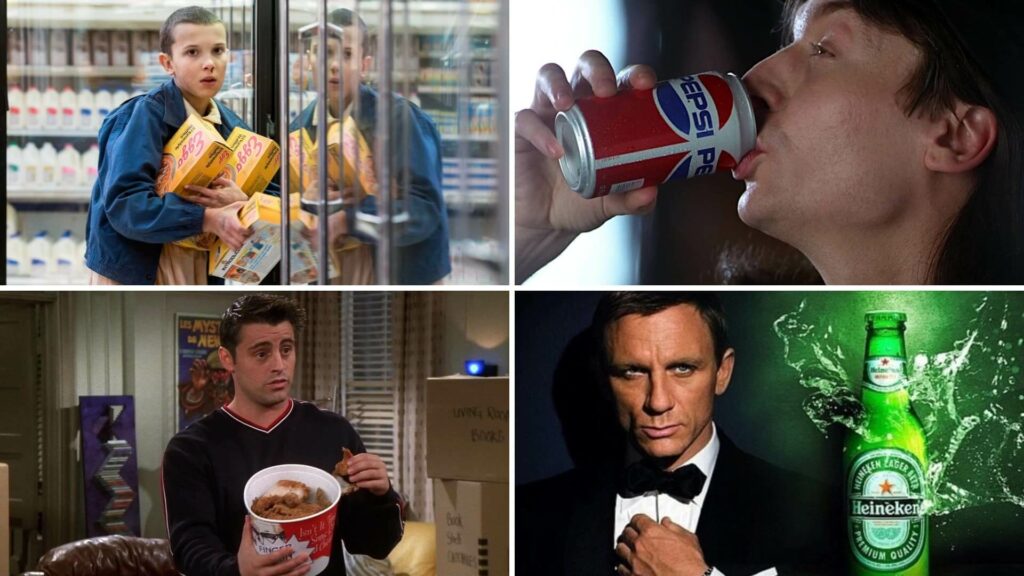Ever notice how your favorite TV character always wears a certain brand of clothes or how the hero in a big movie always uses a specific phone? It’s not by accident.
This is product placement. It’s a marketing tactic so well-hidden in our entertainment that we often don’t realize it’s there. These placements grab our attention and shape our desires without us even knowing.
Product placement is everywhere in movies and TV shows. Sometimes, a real-life ad seems to interrupt the story. This practice highlights the economic side of the entertainment industry. Brands pay for visibility, funding the content we watch. Some placements are more creative than others, standing out in the race for our attention.
In this article, we’ll explore how product placement works in movies and its impact on viewers. We’ll also discuss some memorable examples and their effectiveness.
Table of Contents
What Is Product Placement?
Product placement is a marketing technique. Brands place their products in movies, TV shows, or games. This makes many people notice them. It blends the product into the story. The audience often doesn’t realize it’s an ad. When done well, viewers see the product as part of the show or game. This method lets brands reach people without disrupting their experience. It connects the product with the fun of watching or playing. Product placement is used for:
- Make brands more visible
- Keep consumers interested
- Encourage people to buy
- Help people remember the brand
The History of Product Placement in Movies
In the 1980s, brands would provide products for filming without any guarantees. This approach changed with the movie “E.T.” in 1982. Originally, the team wanted to use M&Ms to attract E.T., like feeding a pet. But the Mars company refused, not wanting to be associated with aliens. Instead, they used Reese’s Pieces from Hershey.
The team filmed the candy scenes without overt advertising. Later, Hershey agreed to a million-dollar partnership for six weeks of promotion. They offered an E.T. T-shirt with the purchase of five packs. Kids saw the orange packages in the movie and rushed to buy them. Sales of Reese’s Pieces soared by 65%, even surpassing M&Ms.
After “E.T.,” product placement became a big deal. Brands started approaching film producers, reducing production costs. It saved time for teams looking for props. Sometimes, the placement was free for the brand, as long as the product fit well in the story.
A famous example is Ray-Ban. Sales were dropping until Tom Cruise wore Wayfarers in “Risky Business” in 1983. Sales jumped to 360,000 pairs that year. Later, the Aviator model became popular after “Top Gun.”
In the 1990s, agencies started managing product placements. They offered catalogs of products to filmmakers. Sometimes, movies had so many placements that they lost the subtlety of organic placement. This led to many close-up shots of products, making them feel like ads.
In France, the series “10 pour cent” depicts agents trying to place both actors and products. While product placement is regulated in Europe, it is allowed in films, TV shows, and music videos, except for children’s content. Certain products, like alcohol and tobacco, are banned from promotion.
In the 2000s, brands started integrating directly into movie scripts. This is called brand integration. Brands and producers sometimes shared production costs. The brand then benefited from the movie’s success and gained significant exposure.
However, many popular shows are set in different eras or fictional worlds. This makes product placement tricky. Coca-Cola succeeded with “Stranger Things” by reintroducing 1985 “New Coke” cans in the third season. This created a nostalgic connection and fit well with the show’s timeline.
Some movies made fun of obvious product placements. In “Wayne’s World,” the characters mock the concept by blatantly showing Pizza Hut and Reebok products. This humorous take made the brands memorable without feeling like heavy advertising.
“Fight Club” also criticized consumer culture. The main character mocks his obsession with Ikea products. Throughout the film, brands are either destroyed or criticized, highlighting the absurdity of consumerism.
Quentin Tarantino often uses fictional brands in his films. Examples include Red Apple cigarettes and the Big Kahuna Burger. These brands appear across multiple movies, creating a unique universe without real-world advertising constraints.
Some fictional brands become real due to their popularity. For example, Bubba Gump Shrimp Co. from “Forrest Gump” became a real restaurant chain. Established in 1996, it now has locations in the U.S., England, Asia, and Mexico.
Product placement has evolved significantly. From early, subtle integrations to today’s brand integrations, it remains a powerful marketing tool. It shapes how we perceive brands and integrates them into our entertainment experiences.
Types of Product Placement in Movies
Product placement isn’t all about showing a product on screen. There are different types, each with its own impact.

Plot Placement
Plot placement means the product is part of the story. It’s not just there; it plays a role in the plot.
Take the 1982 movie E.T. the Extra-Terrestrial. E.T. loves Reese’s Pieces. Elliott uses the candy to connect with him. This type of placement made Reese’s Pieces very popular. The company paid $1 million for this. Sales of the candy doubled soon after the film came out.
Product placement like this has been around for over fifty years. But E.T. showed how powerful it could be. Brands and movies saw how much they could gain from working together. Other examples include the Nike shoes in Forrest Gump and the Wilson volleyball in Cast Away. If a product fits naturally into the story, it can be very successful.
Script Placement
Script placement is rarer. It happens when a brand is mentioned in the dialogue. Screenwriters have to be careful. They need to get clearance for the brand. Scripts can change a lot, and brand names might get cut.
An example is Marty McFly asking for a Pepsi in Back to the Future. The brand became part of the final film.
Screen Placement
Screen placement is common. The product is shown but not mentioned. It doesn’t affect the story. It’s just there for the audience to see.
Think of Maverick’s Ray-Bans in Top Gun or James Bond’s Aston Martin and Omega watches. Even the phone a character uses can be a screen placement. Companies pay to have their products shown this way. It’s subtle but effective.
Advantages of Product Placement for Companies
Product placement in movies has several benefits:
Wide Reach
- Product placement helps a brand reach many people for a long time
- Movies play in theaters, on TV, and online. This means the product is seen by a large audience over many years
Strong Exposure
- Moviegoers focus on the screen. The dark theater, loud sound, and seating arrangement help viewers pay attention
- This strong focus means the product gets noticed more
Frequency
- Some people watch movies more than once. Each time they see the product, it increases the chances they will remember it
- The more times a product appears, the higher the frequency of exposure
Source Association
- When a celebrity uses a product in a movie, it can boost the product’s image
- Fans may want to use the same product as their favorite stars
Better Recall
- Seeing a product in a movie can help people remember it better than seeing it in a TV ad
- The wide coverage and repeated exposures in movies help with recall
Bypassing Regulations
- Product placement can avoid some advertising laws. For example, it can promote alcohol or cigarettes without legal issues
- This gives brands a way to advertise products that have stricter rules in traditional ads
Effective Targeting
- Choosing the right movie ensures the product reaches the right audience
- Unlike TV ads, viewers can’t skip product placements in movies. This guarantees the product will be seen
Key Risks of Product Placement
Here are some risks associated with product placement:
Time of Exposure
- Viewers might not notice the product unless the camera zooms in or the main character mentions it
- Movies can’t give detailed information about the product’s features
Limited Appeal
- Manufacturers may not meet their expectations due to factors beyond their control
- For example, a movie release might get delayed, or the audience might not match the target market
Lack of Control
- Public reactions to product placement can be unpredictable and sometimes negative
- Social concerns can arise from product placement
Public Reaction
- Many movies use product placement, making it hard for marketers to stand out
- Competing brands in the same movie can confuse the audience
Competition
- Competing products in the same movie might send mixed messages
- For example, one brand might be associated with villains, while another is linked to heroes
Examples of Product Placement in Movies
Here are some examples that can be seen in the movies:
Refrigerators and Food Brands
When Larry David opens a fridge in “Curb Your Enthusiasm,” viewers see brands like Perrier water, Pacific chicken broth, and Clover cottage cheese. This placement gives these products a few seconds of screen time.
Early Beginnings
The first known product placement was in 1896. The Lumière brothers featured soap in their film “Washing Day in Switzerland.”
Rise with Streaming
With streaming services growing, product placement has increased. Brands want to be seen, and productions need to cut costs. This has made product placement a $23 billion industry.
Core Hydration
Core Hydration water appears in shows like “He’s All That,” “Riverdale,” and “How I Met Your Father.” The distinctive blue top and bottle shape make it recognizable.
Dell Products
Dell laptops and monitors are seen in “Succession.” They help create a corporate setting. Dell also appears in “The Sex Lives of College Girls” and “And Just Like That.”
Eggo Waffles
“Stranger Things” featured Eggo waffles. This placement revived the brand, increasing its sales by 14 percent after the show’s first season.
Cheerios
Cheerios often appear in shows like “Grace and Frankie,” “Inventing Anna,” and “Mare of Easttown.” These yellow boxes are easy to spot and remind viewers of breakfast.
BlackBerry
In “House of Cards,” Kevin Spacey’s character uses a BlackBerry. This was established early in the show and couldn’t be changed later.
Zillow
Zillow, the real estate site, appears in shows like “Grace and Frankie” and “Never Have I Ever.” Verbal mentions, like “I Zillowed his house,” help integrate it into the script.
Peloton
In “And Just Like That,” a character has a heart attack while riding a Peloton. This led to a real-life drop in the company’s stock price.
Jaguar SUV
In “The Equalizer,” Queen Latifah drives a Jaguar SUV. The car was chosen for its cool yet practical image and was provided for free in exchange for the exposure.
Nike
In “Forrest Gump,” Nike shoes play a significant role. Forrest wears them during his cross-country run.
Wilson
In “Cast Away,” Tom Hanks’ character befriends a Wilson volleyball, giving the brand significant exposure.
Aston Martin
James Bond movies prominently feature Aston Martin cars, associating the brand with luxury and sophistication.
Pepsi
In “Back to the Future,” Marty McFly asks for a Pepsi, integrating the brand into the film’s dialogue.
Ray-Ban
Tom Cruise wears Ray-Ban sunglasses in “Top Gun,” boosting the brand’s popularity.
Reese’s Pieces
“E.T. the Extra-Terrestrial” features Reese’s Pieces, leading to a significant increase in the candy’s sales.
Omega
James Bond also wears Omega watches, highlighting the brand’s association with elegance and precision.
Apple
Apple products frequently appear in movies and TV shows, such as MacBooks in “Sex and the City” and iPhones in many modern films.
Heineken
James Bond is seen drinking Heineken beer in “Skyfall,” bringing attention to the brand.
Audi
The “Iron Man” movies feature Tony Stark driving Audi cars, associating the brand with innovation and high-tech.
FedEx
In “Cast Away,” FedEx plays a crucial role, as the main character is a FedEx employee, and the company’s packages appear throughout the film.
Dr. Pepper
In “Spider-Man: Homecoming,” Dr. Pepper is frequently seen, subtly promoting the brand.
These examples show how product placement can vary from subtle background items to key plot elements, helping brands gain visibility and recognition.
Product placement in movies is a dynamic and influential marketing strategy. From iconic scenes to subtle appearances, these placements can significantly impact consumer behavior. As the entertainment industry continues to evolve, product placement will remain a powerful tool for brands. It helps connect with viewers and shape their perceptions. This blend of marketing and storytelling funds our favorite content. It enhances the viewing experience, making it an essential part of modern media.
Stay tuned to your favorite movies and TV shows, and see if you can spot the next clever product placement. It’s more than just a background prop – it’s a key part of the story that might just influence your next purchase. Visit our website for more informative articles.



















